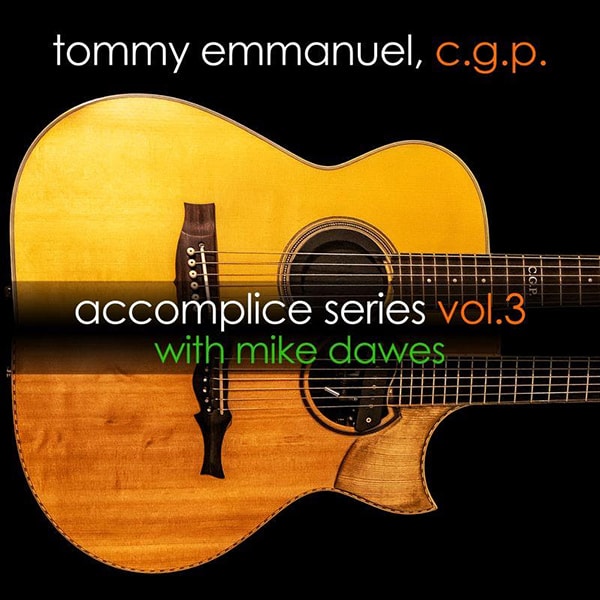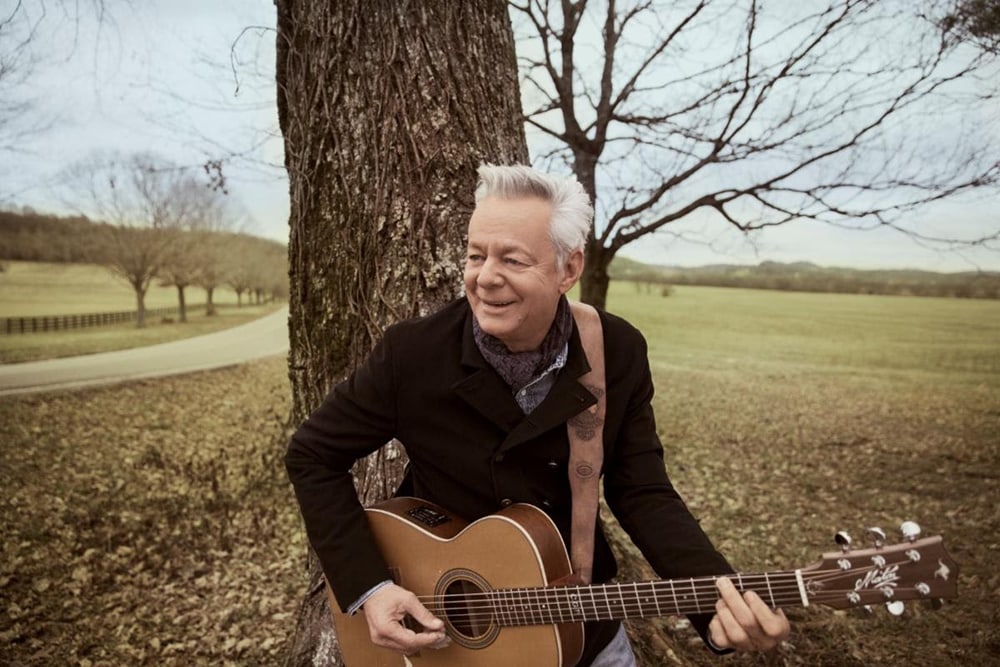When guitar great Chet Atkins names you as one of only five guitarists he considers a “Certified Guitar Player,” you know that you have reached the top of your game. For Chet, it meant that you had excelled far beyond the normal boundaries of playing. Those five players include Steve Wariner, Jerry Reed, John Knowles, Paul Yandell, and last but certainly not least, the incomparable Tommy Emmanuel.
For decades Emmanuel has been wowing audiences with not only his dizzying guitar skills but his singular sense of showmanship. Fellow players not only marvel at his expansive sense of musical imagination, but his capacity to make each performance electrifying to every audience member, regardless of how well they know guitar. Watching Tommy perform can become hypnotic as he draws you into his music as if he was casting a spell.
Tommy Emmanuel uses a style based on country fingerpicking that leverages the openness of jazz, the speed and technical prowess of bluegrass, the songwriting constructs of folk, and the fierceness and authority of rock and roll. He uses a combination of fingerpicking, a thumb pick, flatpicking (using a standard-type pick), and some unusual fingerings and techniques. He can move from an acoustic explosion to a delicate interlude with skills that most would argue are unparalleled.
A few years back he began a recording project of a series of albums called the Accomplice Series. The first, Accomplice Series Vol. One, was more of a “variety pack,” where he partnered with different kinds of vocalists and players across a collection of songs that covered a wide range of musical ground. Accomplice Series Vol. Two, with acoustic guitarist Richard Smith, was a spectacular homage to Chet Atkins and Jerry Reed. Now comes a third edition, to be released on September 23 on CGP Sounds. Here he partners with British guitar picker Mike Dawes, with whom he has just toured.
Accomplice Series, Vol. 3 is a five-song EP that showcases their rare union and remarkable skills. It begins with an electrifying (though played on acoustic guitars) version of Nirvana’s “Smells Like Teen Spirit,” and is followed by Sting’s “Fields of Gold” and John Mayer’s “Slow Dancing In A Burning Room.” Here, their approach adds air and space to the songs, allowing guitar moments to float and fly with ease. But it’s on The 1975’s ”Be My Mistake” and Gotye’s “Somebody That I Used to Know” where the duo takes what were already-hypnotic vibes and creates trance-like moments that make the songs even more compelling.

Accomplice Series Vol. 3, album cover.
Copper had the opportunity to speak with Tommy Emmanuel about this record, his legacy, and the commitment he has shown to mentoring up and coming guitar prodigies.
Ray Chelstowski: This is your third record in the Accomplice series. They are all widely different. How do you determine what these volumes should look like?
Tommy Emmanuel: It’s all about the chemistry that I have with the person I’m recording with. I put an album out about four or five years ago called Accomplice Vol. One which was basically a chance to do duets with other artists. I didn’t want to use the words “duet” or “duo” and I found the word “accomplice,” and it just seemed so distinct. The Accomplice series is really about the chance to record more than one track with someone that I particularly like playing with or that I had a particular chemistry with.
Some of them have singing parts and some are just instrumental. The first one that I did was with Trey Hensley and Rob Ickes and that was more bluegrass and some original tunes. Then I did one with Richard Smith, which was a tribute to Chet Atkins and Jerry Reed. This last one that I’ve just done is with Mike Dawes. Mike and I met each other years ago and he just brought something so different to the table, and I love having him with me at my shows. He’s a great performer and he is really out there to play for the people. One night we were messing around playing tunes in the dressing room and I tried to hone in on all of his strengths in playing. I basically let him be “the singer” and I played the melody without getting in the way. Then there were other songs where he had already had his own arrangements and I just came in and doubled the chorus and created harmonies around what he was doing. As two players it worked really well.

Mike Dawes. Courtesy of Adam King Photography.
RC: How did you settle on these five songs?
TE: We didn’t have a lot of songs to choose from because of the nature of Mike’s playing. We had to find songs where I could play melody and harmony, and he was already playing most of these songs as solo pieces. He would play them to me and then I worked out what I could do and it all just seemed to fit together.
RC: How did you and Mike approach the project? Were songs mapped out before you went into the studio or was it largely improvisation?
TE: We basically work out the song, and then when it’s time for solos it’s total improvisation. That’s how we did it. When you watch the video of us doing “Smells Like Teen Spirit” that’s absolutely live and not exactly the same as the recording. With other songs like “Somebody I Used to Know,” I had to find a way to not get in the way of what he was doing, but to bring something that added something to it. “Be My Mistake,” is beautiful, and he had it all down. I just had to find a way of adding some colors and another voice. With “Fields of Gold,” he already had a nice arrangement going with that and I just doubled the melody.
We did a tour in January and played a lot of shows in a row, practiced together at sound checks, and found what really worked. When the tour finished, we stayed in Los Angeles and went to a friend’s studio and played live and recorded this. That’s how it came together. We didn’t spend a lot of time on it. Most of the pieces were captured in the first or second take.
RC: As someone who has covered a wide range of songs, do you know when one is right for you to interpret?
TE: First of all, I have to like the song. I have to really like the melody and it has to work for Mike and I to play. We can have a go at anything but not everything works. When people say something to me like, “Why don’t you play this Beatles song?” I tell them that not all Beatles songs work as instrumentals. You have to find what works as an instrumentalist. It’s a whole different world being a singer and an accompanist. You have to find what works where you can still tell the story without words.
RC: You are one of five players that Chet Atkins named Certified Guitar Players. What was the moment where you realized that maybe you were that good?
TE: I would never think something like that (laughs). I’m just fumbling my way through life like everyone else and finding what works for me. I have had several different goes of doing different things and when it came time for the red [recording] light to go on I didn’t have something to say. It’s then that I have to be honest and say that I’m not going to play anything on this, that I’m not the right person. It’s really a matter of finding music where I can put my emotions and my abilities to work in an honest way. For example, with “Teen Spirit,” I had listened to the original version by Nirvana many times and then we just decided to throw ourselves into it and find a way of making it ours.
RC: You’ve played alongside world-class guitarists like Les Paul, Frank Vignola, and Chet Atkins. Who has pushed you the most?
TE: Well, last weekend I was a guest teacher at Steve Vai’s camp in Las Vegas. That was fun! When Steve and I got to jam on some tunes I switched to electric guitar and we had a lot of great interaction. He likes to push me out on the limb and I like to do the same to him. We fed off each other. It was brilliant.
RC: Is there a practice regimen that you follow when you’re not on tour?
TE: I play whenever I feel like it. I don’t have a specific regimen. I’ve never been that kind of person. But I do go through stages of practicing a real lot, then to just playing for fun and trying new things. My normal routine is that when I get to the theater where I’m scheduled to play I go straight to the dressing room and get my guitar out and start playing. I run through tunes I haven’t played in a while and I’ll start to push myself, play slow, play fast, play soft, and play loud. I’ll try a bit of everything to get myself physically and musically in the zone. Then usually at sound check I’ll play like it’s the show. It’s good for me to do that because it gives me an idea of what the sound is really like. My sound man needs me to play that way too because we need to set levels to that I don’t overdrive things or push channels into compression. I tend to play full-out at sound check.
RC: You’ve played with so many up-and-coming guitarists like Billy Strings. What advice do you give them?
TE: I’ve known Billy for quite a few years and people like him don’t need my advice. He’s doing very well. But for young people who are finding their way and who want to be doing what I’m doing, my best advice for them is to learn some good songs. Have some good songs and good arrangements to play because you’re going to need them. And, with them, you’ll learn so much about music and performance. I could tell you to do all kinds of other stuff like work on your time or work on your tone. But most young people will find that anyway as they go along. My advice is always to learn some good songs and learn what a good song truly is.
RC: You are known for your love of live performance and making people happy through your music. After all of these years is it still as much fun?
TE: Oh yeah! Touring is how I make a living. But touring is also good for my playing. It forces me to play all of the time and it forces me to get better. I always wish that I could record an album at the end of a tour where I’m at my best, when everything has been sharpened by night after night of pushing myself.
It’s great. I get to hang out with friends and experience different places and cultures. It’s so wonderful.
Header image of Tommy Emmanuel courtesy of Alysse Gafkjen.


